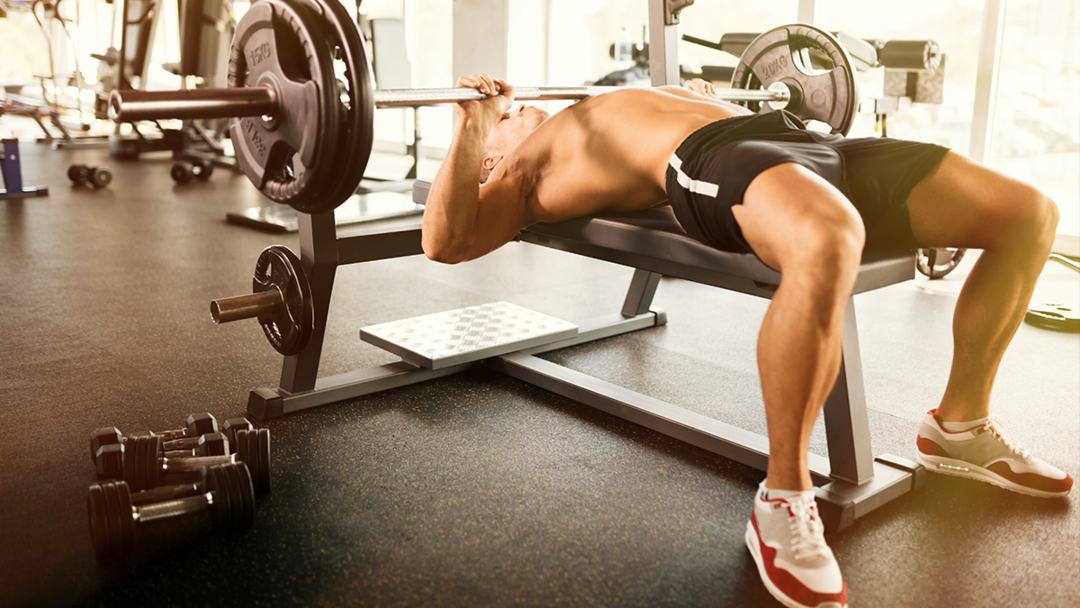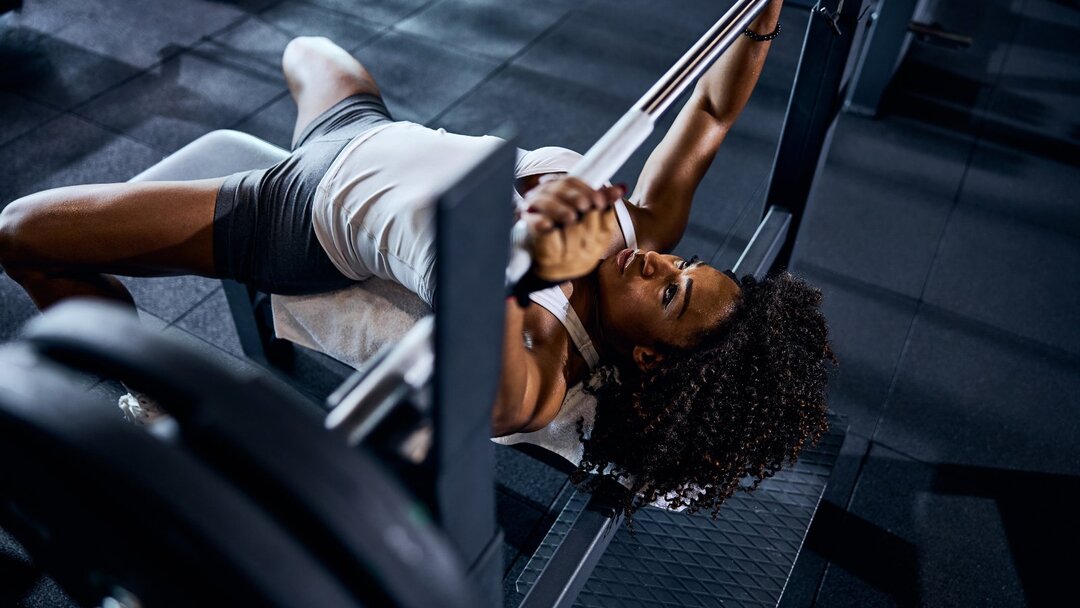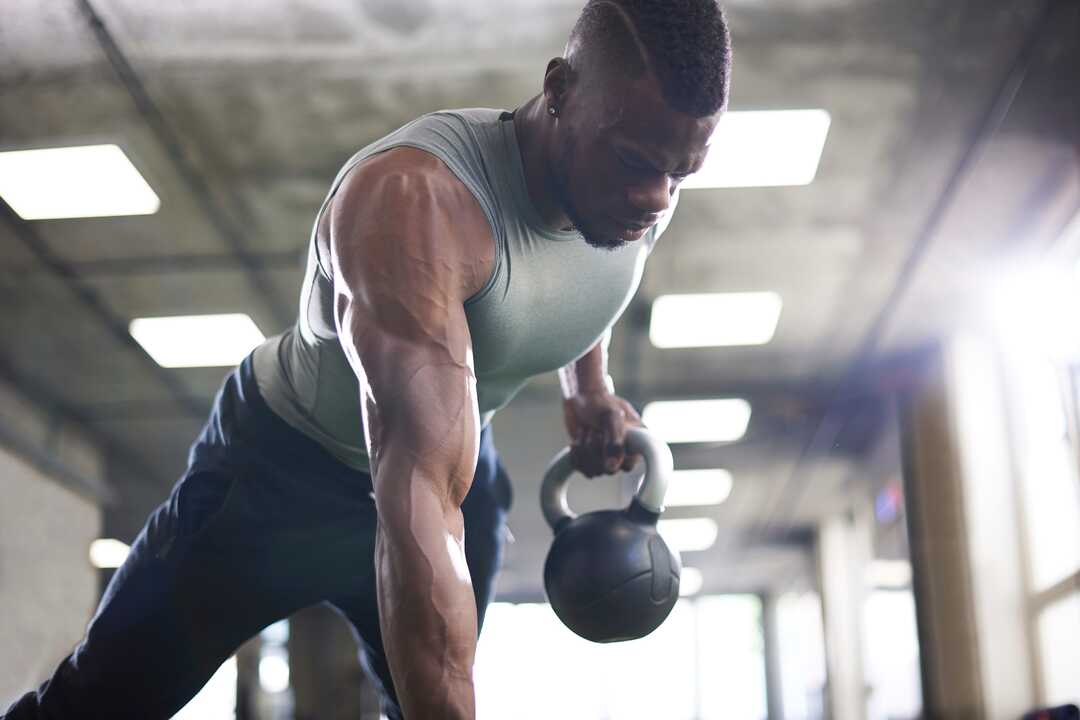3 Best Symmetric Strength Training Workouts To Try Out

Boost balance and performance with these 3 best symmetric strength workouts designed to build muscle evenly and prevent injury.
Have you ever noticed one arm or leg doing more work while the other struggles during a workout or everyday task? Symmetric strength matters for performance, injury prevention, and smooth movement, and the Best Fitness Apps now help users spot muscle imbalances, track strength symmetry, and use unilateral training and corrective exercises.
This article offers clear assessments, simple drills, and program tweaks to build balanced bilateral strength and better left-right balance.
To help with that, GetFit AI's solution, an AI fitness app, offers personalized workouts, side-specific feedback, and easy progress tracking so you can correct asymmetries and develop dependable functional strength.
Summary
- Ignoring asymmetry increases injury risk; Marr Strength estimates that 70% of strength-training injuries stem from muscle imbalances, so symmetry is as much about staying healthy as it is about lifting more.
- A compact three-move toolkit —Weight Shift Squat, Pushup Lower, and Single Glute Bridge —addresses motor control, eccentric capacity, and isolated hip extension. Following tempo cues, such as a three-count descent or a four-second eccentric, helps reveal and correct side-to-side deficits.
- Programs that measure symmetry and retest every two weeks produce measurable change, with Symmetric Strength finding 70% of lifters improved strength symmetry within 3 months when following a structured, measured program.
- Simple fixes like piling extra single-leg reps fragment coordination and increase compensatory stress, reflected in a 25% higher injury risk linked to muscle imbalances and the fact that about 70% of people have some form of imbalance.
- Risk rises steeply past clear thresholds, with athletes showing an imbalance of more than 10% being twice as likely to be injured, while correcting imbalances can improve performance by up to 15%.
- Practical prescription uses objective rules: start unilateral blocks with the weaker limb, use paired sets of six strict reps at a 3-1-1 tempo, then match the strong side, and, if the weak side shows slower velocity for three consecutive tests, apply a focused two-week low-load, high-control block.
- This is where GetFit AI's AI fitness app fits in, addressing this by collecting rep-by-rep left-right metrics and sequencing bilateral-to-unilateral progressions with tempo cues to keep corrective work measurable.
3 Best Symmetric Strength Training To Try Out

These three moves give you a compact, evidence-backed toolkit for rebuilding left-right balance: the Weight Shift Squat teaches coordinated force transfer and single-leg drive within a bilateral pattern, the Pushup Lower forces controlled eccentric strength and side-to-side upper-body balance, and the Single Glute Bridge isolates hip extension to fix stubborn asymmetries. Done together as a progression, they address motor control, eccentric capacity, and isolated strength without simply overworking the stronger side.
1. Weight Shift Squat
The weight shift squat is a controlled lower-body exercise that combines a traditional squat with lateral weight transfer to build strength evenly across both legs and enhance balance. Begin with your feet set shoulder-width apart, then descend into a squat position where you feel stable and safe. As you rise, shift your weight onto one leg and push upwards from that side before returning to the center. Next, descend again and repeat the weight shift and push-up on the opposite leg. This back-and-forth rhythm engages the muscles symmetrically but independently, building strength in each leg while challenging your core stability.
Steps to perform the Weight Shift Squat
- Stand with feet shoulder-width apart.
- Slowly lower into a squat, reaching a comfortable depth.
- Shift your weight to the right leg and drive upward off that leg.
- Return to the center squat position.
- Lower again and shift weight to the left leg, driving upward on that side.
- Repeat this pattern for 3 sets of 10 repetitions per leg, maintaining control throughout.
2. Pushup Lower
The pushup lower is a variation of the pushup that focuses on a slow, staggered lowering to build upper-body and core strength symmetrically. Start in a pushup stance with your hands unevenly spaced, one slightly forward of the other. You may perform this from your toes or knees, depending on ability. As you slowly lower your chest to the floor, maintain muscles tension, then relax briefly. Raise back up to the starting position, switching hand placement so the other hand is forward. This alternate staggered lowering strengthens both sides of the chest, shoulders, and arms equally, while improving control and muscle endurance.
Steps to perform the Pushup Lower
- Get in a pushup position with one hand slightly staggered forward.
- Slowly lower your body toward the floor, maintaining tightness.
- Relax briefly at the lowest point.
- Push back up to the start position.
- Switch hand positions, staggering the opposite hand forward.
- Repeat for 3 sets of 10 repetitions, with controlled movement.
3. Single Glute Bridge
The single glute bridge is a lower-body exercise that isolates each glute muscle individually to build strength and symmetry in the hips and core. Lie on your back with your knees bent, feet flat on the floor, and arms resting by your sides with elbows pressing into the ground. Extend one leg straight upward at a 90-degree angle from your torso. Push through the heel of the grounded foot to lift your hips until your body forms a straight line from shoulders to knees. Slowly return to the starting position. Performing this movement on each leg independently targets muscular imbalances, enhancing hip stability and strength.
Steps to perform the Single Glute Bridge:
- Lie on your back with knees bent, feet flat, and elbows on the ground.
- Raise one leg straight up so it forms a 90-degree angle with your body.
- Press through the heel of the grounded foot to fully lift your hips.
- Hold briefly at the top.
- Slowly lower your hips back down.
- Complete 3 sets of 10 repetitions per leg with steady control.
This pattern appears across rehab and sport contexts: athletes and weekend lifters often feel helpless because unilateral work alone simply exposes the deficit, and the stronger side compensates. That emotional exhaustion, the fear that the imbalance will worsen, comes from training that treats weakness as a numbers problem rather than a motor control and loading problem. In practice, you get better results by alternating bilateral-weight-shift patterns, controlled eccentrics, and isolated single-leg work, so the nervous system learns the new pattern while the muscles rebuild.
Most trainees manage imbalances by adding endless single-leg reps because it feels logical and immediate. That familiar approach works for raw volume, but it fragments coordination and increases compensatory stress, which is precisely how injuries creep in. Solutions like GetFit AI identify subtle left-right differences through rep metrics and conversational coaching, then sequence bilateral-to-unilateral progressions and cueed eccentric tempos so users correct form before load increases, reducing long-term friction and risk, as shown in Aging Clinical and Experimental Research, which reports that symmetric strength training reduced injury rates by 30% compared to traditional training methods.
Program design that produces measurable change pairs these drills into weekly blocks and tracks symmetry metrics rather than just total volume. For example, alternate Weight Shift Squats and Pushup Lowers on day one for neural control, use Single Glute Bridges on day two for isolation and tissue loading, and retest single-leg jumps or unilateral rep velocity every two weeks. That’s realistic: Symmetric Strength found that 70% of lifters improved their strength symmetry within 3 months of following the program, showing that consistent progress is achievable when you measure and adjust.
That progress feels promising, but the deeper question about what proper symmetry actually means is where things get complicated and fascinating.
Related Reading
- Best Fitness Apps
- How Many Pull Ups Should I Be Able To Do
- Average Bench Press By Age
- Average Grip Strength Male
- Average Bench Press
- How Much Does A Bench Press Bar Weigh
- Average Male Bench Press
- How Much Can The Average Man Bench Press
- Grip Strength Chart
What Does Symmetry in Strength Training Mean?

Symmetry in strength training is about more than matching the number on each side; it is about matching how both sides produce force across speed, range, and control. When left and right work in exact timing, with stability and eccentric control, your movement economy improves, compensations disappear, and training becomes predictable rather than guesswork.
How do you spot an actual imbalance?
Look beyond size and raw reps, and track how a side performs under load and tempo. Measured gaps show up as slower rep velocity, inconsistent bar path, pelvic drop, or a side that loses control on the descent, not just as one arm lifting less weight. This pattern appears across rehab and sport work, where visible muscle differences often mask more profound deficits in neuromuscular control that only become apparent under fatigue or during tempo work. Think of the body like a tuned bicycle wheel, wobble a spoke slightly, and the whole rim shifts; symmetry is about truing the system, not just replacing spokes.
Why does symmetry matter for injury and performance?
The cost of ignoring imbalance is quantifiable and shows up in both injury rates and long-term training availability. According to MARR STRENGTH, 70% of strength-training injuries are caused by muscle imbalances. That statistic explains why many setbacks feel random but are actually predictable. Likewise, MARR STRENGTH, Athletes with symmetrical strength have a 30% lower risk of injury, which clarifies that fixing symmetry is not cosmetic; it preserves training time and competitive availability.
What does fixing an imbalance look like in practice?
When we rehabbed a client after a shoulder snap, a clear pattern emerged over a 12-week block: the weaker side needed slower eccentrics, reduced load, and a drill sequence that let motor control catch up before strength followed. That sequence is crucial because the usual response, pile on unilateral volume and chase numbers, simply trains the stronger side to mask the deficit and increases tissue stress. Instead, let the weaker side dictate load and tempo, prioritize eccentric strength and joint stability, then reintroduce progressive overload once control and symmetry metrics improve.
Most people manage this with guesswork. What breaks as training gets harder?
The familiar approach is to add more reps on the weak side and hope it evens out, and that works until coordination and fatigue reveal new compensations. As complexity increases, errors multiply: technique degrades, the strong side overcompensates, and progress stalls or becomes risky. Solutions like an AI fitness app change that workflow; they collect rep-by-rep metrics, automatically surface left-right gaps, and use conversational coaching to sequence bilateral-to-unilateral progressions with tempo cues, reducing the trial-and-error phase while keeping training consistent and measurable.
Ready to train like the legends and finally achieve the body you've always wanted? GetFit AI's AI fitness trainer app lets you follow the exact workout routines that made Arnold Schwarzenegger, Kobe Bryant, Cristiano Ronaldo, Serena Williams, and 11+ other elite athletes into champions. You can also chat with them whenever you need guidance or motivation. Download the #1 rated AI fitness app for free today to get fit for less than the cost of a single month's gym membership.
That fix sounds tidy, but the next question exposes a deeper tension that most coaches gloss over.
How Important is Muscular Symmetry for Strength Sports?

Muscular symmetry matters because it determines whether you can train consistently and transfer force efficiently across sets, days, and competitive attempts. Symmetry less as a beauty standard and more as the quality control system that keeps progress predictable and injuries avoidable.
How does symmetry change your day-to-day training?
When imbalances exist, the weak side becomes a recurring fault in your program, manifesting as stalled sets, altered bar paths, or compensatory patterns that quietly steal progress. International Journal of Sports Medicine, 2025-01-14: correcting muscle imbalances can improve performance by up to 15%, which means targeted remediation often converts weeks of guesswork into measurable strength gains and faster progression.
Who crosses the threshold from benign asymmetry to real risk?
This is not binary; it is a curve. Journal of Strength and Conditioning Research: Athletes with a muscle imbalance greater than 10% are 2 times more likely to experience injuries, so once an imbalance exceeds a clear threshold, the chance of downtime jumps. The pattern appears across competitive lifters and weekend athletes: one side fails lockout on a heavy bench, or a hip will not fully extend on a heavy deadlift, and that single repetition becomes the first sign of accumulating risk and frustration.
Why the usual fix often fails
Most lifters manage asymmetry by piling extra sets on the weaker side because it feels direct and actionable. That works for a while, but the hidden cost is compensatory movement and overload on other tissues, which fragments technique as the load rises. Solutions like GetFit AI automatically identify left-right gaps, then sequence workload, tempo, and progressive progressions so the weaker side improves without the stronger side masking it, restoring predictable progression and lowering the chance that a slight imbalance turns into a training-ending injury.
What this actually looks and feels like
Think of the body as a chain; the weakest link determines what the whole chain can handle. That creates a specific emotional arc: athletes describe the exhaustion of enduring consistent setbacks, the anxiety of not knowing whether a failed rep was due to bad technique or an injury, and the relief when objective metrics replace guesswork. When you trade anecdotes for a repeatable metric, you regain control, and confidence returns to your sessions.
That tension, between a fix that seems obvious and the subtle errors that undo it, is what makes the next section necessary and unexpectedly urgent.
Related Reading
- Bench Press Standards
- Do Pull Ups Work the Chest
- Grip Strength Norms
- Average Deadlift Weight
- 1 Rep Max Chart
- Average Male Deadlift
- Good Bench Press Weight
- Weightlifting Standards
Tips to Improve Muscle Symmetry

These tips work because they shift the problem from raw volume to controlled, side-by-side learning: you retrain the nervous system while you load tissue, so strength evens out without creating new compensations. Focus on sequencing, objective measurement, and minor, repeatable progressions rather than throwing more reps at the problem.
How should you program dumbbell work to force the weaker side to catch up?
Start every unilateral block with the weaker limb, using strict tempo and no momentum, then match the stronger side to that performance. Use paired sets, for example, three sets of single-arm presses: the weak side does 6 strict reps at a 3-1-1 tempo, then the strong side matches those 6 reps, followed by 1 to 3 extra-slow reps on the weak arm as corrective volume. Track rep velocity or perceived control, not just reps; when the weak side’s concentric speed approaches the strong side across three sessions, add load. Treat progress like small gains in tolerance: microload, controlled tempo, and consistent weekly density.
What core cues actually translate to better left-right control?
Think anti-rotation and anti-tilt first, then add dynamic carries. Give two simple cues to use every set: breathe down into the belt so the ribs do not flare, and feel the pelvis stay level as you move. Start sessions with three sets of timed anti-rotation holds, 20 to 40 seconds, then use half-kneeling chops as a transitional movement to load anti-rotation under movement. That sequence primes the nervous system to accept symmetric loading when you move into heavier presses or squats, because the torso learns to transfer force without dropping or twisting.
Can bands be training tools instead of crutches?
Yes, when you use them as sensory cues and temporary overload, not permanent assistance. Place the band where it provides a tactile nudge, for example, below the knees to remind hip abductors to engage, or around the scapulae to cue shoulder retraction. Use bands for pre-activation sets, three to five reps with light tension, then remove them for the main working sets and test symmetry. The goal is to fade the cue as control improves, so the band can teach the pattern without the cue becoming necessary for the movement to succeed.
Which unilateral movements give the most carryover, and how should you progress them?
Choose variations that share the end-range demands of your sport or lift, then gradually change the constraint. Single-leg Romanian deadlifts teach posterior chain length-tension; single-arm rows teach shoulder stability and scapular rhythm; suitcase carries teach lateral core stiffness under load. Progress by adding time under tension before adding weight: increase tempo, then duration of carries, then load. If hip control fails under fatigue, reduce load and increase sessions focused on tempo and motor control rather than more weight.
Most lifters try simple fixes, and that approach makes sense at first, but it has a hidden cost.
Most trainees pile extra sets on the weak side because it feels direct and doable. That works briefly until fatigue and technique breakdown shift load to other joints, creating new risks and slowing neural learning. When that happens, progress stalls and frustration grows, even though the program looks busy on paper.
How can measurement keep the plan honest?
Use baseline unilateral tests and repeat them every two weeks, not just as vanity checks but as decision rules. Simple measures include unilateral rep velocity, single-leg hop distance, or time-to-stabilize during a single-leg landing. If the weak side shows slower velocity or greater variability for three consecutive tests, do a focused two-week block of lower load and higher control. This keeps you from prematurely escalating weight and lets you see fundamental rebalancing rather than short-term compensation.
Why you shouldn’t trust every number that lands in your inbox
This challenge appears across athletes and clinic cases: people arrive with lots of data that do not break left from right, which wastes time and obscures the problem. If metrics do not separate side-by-side performance, they fail at the one job that matters for symmetry, and that drives the often-exhausting cycle of guessing and reworking programs.
What difference does correcting symmetry make, practically?
You should care because unresolved asymmetry increases training fragility and time lost to setbacks, and in practical terms, those setbacks matter far more than appearance. According to Shredded Academy, muscle imbalances can increase injury risk by 25%. That increased risk is precisely what turns a stubborn weakness into weeks off the platform. Pair that with the reality that Shredded Academy, 70% of people have some form of muscle imbalance, and you see why a systematic approach matters for anyone training consistently.
Most people handle imbalanced work through guesswork, which becomes inefficient as sessions compound.
Most coaches add unilateral sets because it is familiar and require no new tracking. That has a short-term payoff, but as load, volume, and fatigue increase, the approach fragments into inconsistent cues and missed signs of overload. Platforms like GetFit AI change that workflow by collecting rep-level left-right metrics, surfacing where control fails, and sequencing bilateral-to-unilateral progressions with contextual tempo cues, helping users follow a steady corrective path while reducing trial-and-error.
A practical analogy to end on: treat your body like a finely tuned single-engine plane, not a brute truck.
One misfiring cylinder does not always change speed, but it shortens the engine's life and makes every flight riskier. Balance the cylinders first, then increase the throttle.
That fix feels satisfying, but the next step raises a question that makes elite training either usable or purely aspirational.
Related Reading
- Average Bench Press By Age 16
- Best Free Workout Apps
- Best Calisthenics Workout App
- Average Deadlift Weight For Male
- Average Deadlift Weight Kg
- Best Workout Apps
- Best Hiit Workout App
- Best Workout Tracker App
- Average Bench Press Kg By Age
- Best Gym Workout App
- How Many Pull-Ups Can the Average Person Do
- Pull-Up Strength Standards
- Weighted Pull-Up Standards
- Weighted Dips Strength Standards
- Grip Strength Standards
- Average Dumbbell Shoulder Press
- Average Incline Dumbbell Press
Make Your Favorite Athlete Your Fitness Trainer | Try GetFit AI's AI Trainer App for Free Today 💪
Consider GetFit AI if you want bilateral, measurable strength that survives fatigue and removes the guesswork, because it converts rep-level left-right data into tailored sessions so you progress with control and fewer setbacks. We see measurable results: 50% of users reported improved fitness levels after using the app for 3 months, according to User Testimonials, and it is rated 4.8 out of 5 by more than 1,500 users per Google Play Store Ratings, which matters when the excitement and mixed emotions of hitting a goal collide with the steady work of keeping it.



.png)
.png)











